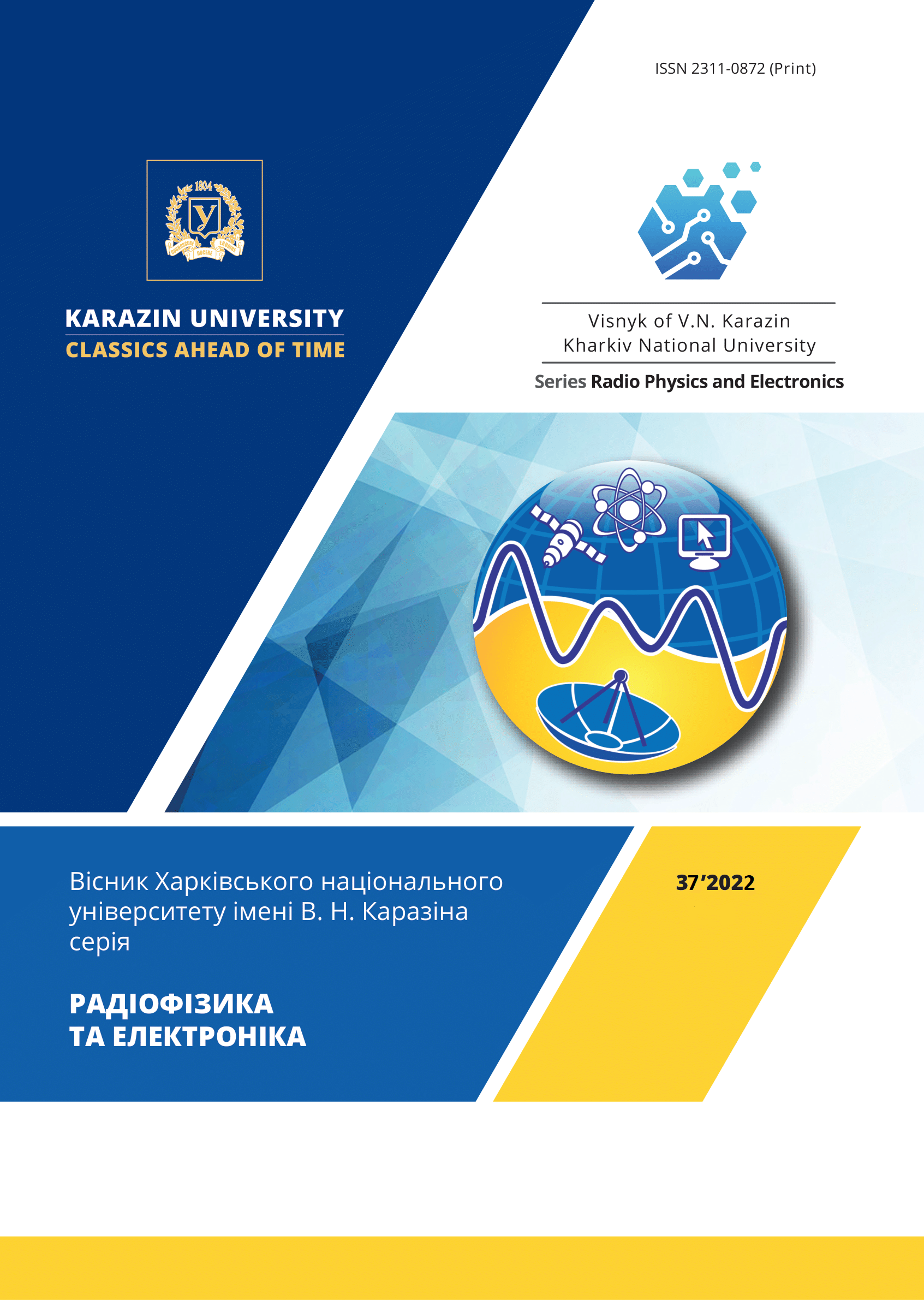Location of objects in a heterogeneous soil using pulse georadar and artificial neural networks
Abstract
Background: Detection of hidden objects in the soil layer is a problem that is important in construction, archeology, humanitarian demining, non-destructive testing of road surfaces, flaw detection etc. Studying the peculiarities of electromagnetic filed behavior in heterogeneous media provides a possibility to create subsurface survey systems that can work effectively in real conditions.
Objectives: To recognize an object hidden in a heterogeneous medium using ultrawideband ground penetrating radar (GPR) and artificial neural network (ANN), to evaluate the performance of a neural network that is trained only on homogeneous medium, to investigate the stability of recognition results in the presence of noise of different levels in the received time dependencies, to compare the results with a network which is trained on heterogeneous media. Check the ability of the ANN to correctly identify typical objects that were not involved in training.
Materials and methods: Modeling of the electrodynamic problem of electromagnetic field propagation is carried out using the finite difference in time domain (FDTD) method. The classification of hidden objects is carried out using the approach of artificial neural networks.
Results: An effective algorithm for detecting objects in a heterogeneous soil model was developed using ground-penetrating radar and ANN. Probability distributions of the classification of hidden objects in presence of additive Gaussian noise in time dependencies were obtained.
Conclusion: The use of ANNs has shown successful results in the classification of objects located in a heterogeneous ground model. The ability to detect objects containing only a few metal parts was demonstrated. The developed algorithm has a high level of noise immunity even at high signal-to-noise levels. The results of detection and recognition of typical objects, which were not involved in ANN training, showed the effectiveness of this approach.
Downloads
References
2. Lewis AL. «Tests and Evaluation of Dual Sensor Mine Detectors based on a Combination of Metal Detector and Ground Penetrating Radar (TEDS)», ),» European Commission Directorate-General Joint Research Centre, AIDCO-JRC Administrative Arrangement No.: MAP/2004/078-257.
3. Zhang Y, Huston DR, Xia T. Underground object characterization based on neural networks for ground penetrating radar data. 2016 Apr 8. https://doi.org/10.1117/12.2219345
4. Dumin O, Plakhtii V, Prishchenko O, Shyrokorad D, Katrich VA. Ultrashort impulse radar for detection and classification of objects in layered medium by artificial neural network. Telecommunications and Radio Engineering. 2019;78(19):1759–70. https://doi.org/10.1615/telecomradeng.v78.i19.80
5. Liu T, Su Y, Huang C. Inversion of Ground Penetrating Radar Data Based on Neural Networks. 2018 May 9;10(5):730-0. https://doi.org/10.3390/rs10050730
6. Miller TW, Borchers B, Hendrickx JMH, Hong SH, Lensen HA, Schwering PBW, et al. Effect of soil moisture on land mine detection using ground penetrating radar. Broach JT, Harmon RS, Dobeck GJ, editors. SPIE Proceedings. 2002 Aug 12. https://doi.org/10.1117/12.479099
7. Sham JFC, Lai WWL, Leung CW. Effects of homogeneous/heterogeneous water distribution on GPR wave velocity in a soil’s wetting and drying process. 2016 Jun 13; pp. 1-6. https://doi.org/10.1109/ICGPR.2016.7572693.
8. Aye Mint Mohamed Mostapha, Ahmed. Faize, Gamil. Alsharahi, Mohamed. Louzazni, A. Driouach. Effect of External Noise on Ground Penetrating Radar Ability to Detect Objects. International Journal of Microwave and Optical Technology 2019;14(2):124-131.
9. Dumin O, Pryshchenko O, Plakhtii V, Pochanin G. Dielectric Object Subsurface Survey by Ultrawideband Radar and ANN. 2020 Sep 15. https://doi.org/10.1109/diped49797.2020.9273400
10. Gürel L, Oğuz U. Transmitter-receiver-transmitter-configured ground-penetrating radars over randomly heterogeneous ground models. Radio Science. 2002 Nov 16;37(6):6–16–9. https://doi.org/10.1029/2001rs002528
11. Gürel L, Oğuz U. Simulations of ground-penetrating radars over lossy and heterogeneous grounds. 2001 Jun 1;39(6):1190–7. https://doi.org/10.1109/36.927440
12. Takahashi K, Igel J, Holger Preetz. Modeling of GPR Clutter Caused by Soil Heterogeneity. 2012 Jul 10;2012:1–7. https://doi.org/10.1155/2012/643430
13. Jiang Z, Zeng Z, Li J, Liu F, Wu F. Simulation and analysis of GPR signal based on stochastic media model. 2012 Jun 4. https://doi.org/10.1109/icgpr.2012.6254863
14. Gürel L, Oğuz U. Simulations of ground-penetrating radars over lossy and heterogeneous grounds. 2001 Jun 1;39(6):1190–7. https://doi.org/10.1109/36.927440
15. Scheers Bart. Ultra-wideband ground penetrating radar with application to the detection of anti personnel landmines. Brussels: Royal Military Academy; 2001.
16. Tellez OLL, Scheers B. Ground‐Penetrating Radar for Close‐in Mine Detection. Mine Action - The Research Experience of the Royal Military Academy of Belgium [Internet]. 2017 Aug 30 [cited 2020 Apr 1]; Available from: https://www.intechopen.com/books/mine-action-the-research-experience-of-the-royal-military-academy-of-belgium/ground-penetrating-radar-for-close-in-mine-detection#B5. https://doi.org/10.5772/67007
17. Ozdemir C, Demirci S, Yigit E. Practical algorithms to focus b-scan gpr images: theory and application to real data. Progress In Electromagnetics Research B. 2008;6:109–22. https://doi.org/10.2528/pierb08031207
18. van der Kruk J, Vereecken H, Diamanti N, Giannopoulos A. Influence of interface roughness and heterogeneities on the waveguide inversion of dispersive GPR data. 2010 Jun 21; https://doi.org/10.1109/icgpr.2010.5550234
19. Windsor CG, Capineri L, Falorni P. A Data Pair-Labeled Generalized Hough Transform for Radar Location of Buried Objects. IEEE Geoscience and Remote Sensing Letters. 2014 Jan;11(1):124–7. https://doi.org/10.1109/LGRS.2013.2248119
20. G. Borgioli, Capineri L, Falorni P, Matucci S, Windsor CG. The Detection of Buried Pipes From Time-of-Flight Radar Data. 2008 Jul 25;46(8):2254–66. https://doi.org/10.1109/TGRS.2008.917211
21. Dumin O, Pryshchenko O, Plakhtii V, Pochanin G. Landmine detection and classification using UWB antenna system and ANN analysis. 2020 IEEE Ukrainian Microwave Week (UkrMW). 2020 Sep 21; https://doi.org/10.1109/ukrmw49653.2020.9252574




